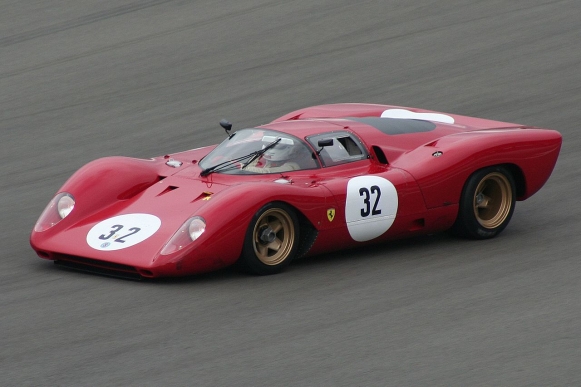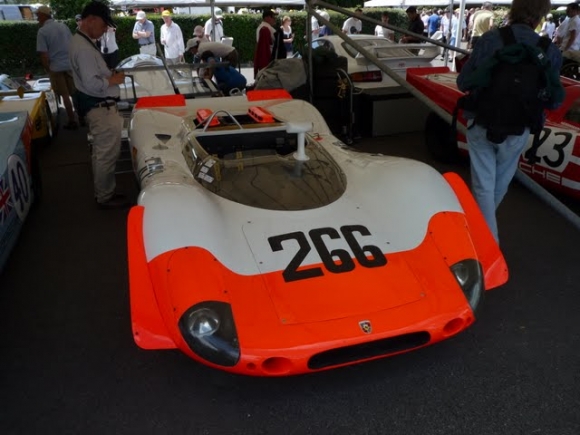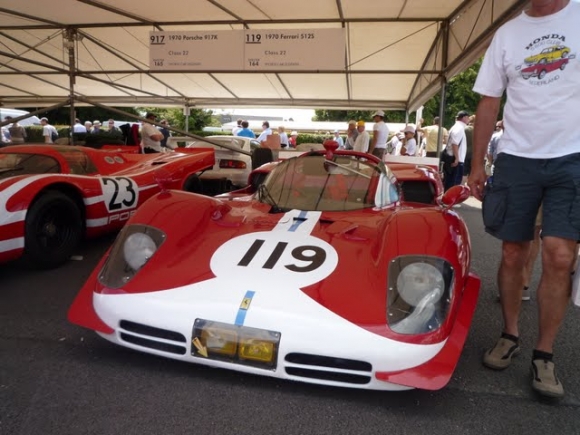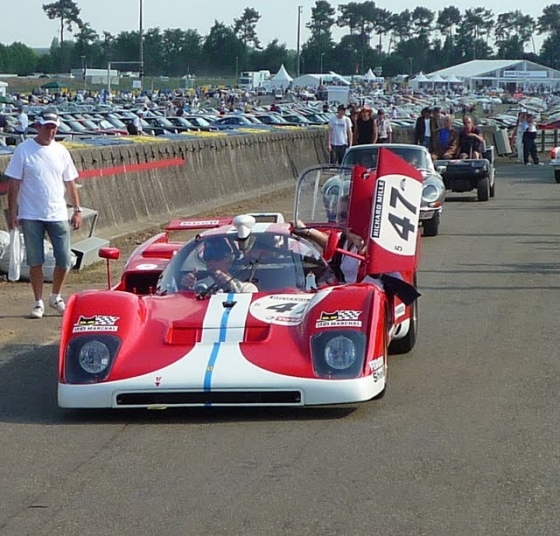In 1969 and 1970 Porsche and Ferrari squared up against one another with monster 5-litre sports prototypes, but who came out on top?
For many car enthusiasts, Steve McQueen's movie Le Mans is considered one the greatest examples of the motorsport movie genre. Filmed in 1970, it mixes real footage of the race with scenes filmed separately but using many of the same cars, and a completely forgettable plot. The movie inadvertently captured something unique in motorsport, since the 1969-1970 World Sportscar Championship that Le Mans was part of is the only time that works Ferrari and Porsche teams competed against each other in the top category of any series. The film portrays a fairly even battle between the two marques, but was that really the case?
To tell this story properly, one needs to go back to 1967 when the predecessor to today's FIA, the Commission Sportive Internationale (CSI), announced that for the following year the World Sportscar Championship would be contested by Group Six sports prototypes of up to three litres (probably not coincidentally the same capacity as Formula 1). This left something of a problem, as there were very few 3.0 litre prototypes around, and so series stalwarts Ferrari and Ford both walked away from the series. In order for grids to be filled, the Group Four category was created allowing cars of up to 5.0 litres to be entered if 50 or more examples had been built. This allowed the likes of the Lola T70, Ferrari 275LM and the older Ford GT40 Mk1s to be entered.
Initially the CSI's plans for the Group Six cars didn't work out as intended, as the only serious entries in the class for 1968 were Porsche with the new 908, and they were beaten to the title by the JWA-run Group Four Ford GT40s. The GT40 also won the Blue Riband event for the series, the 24 Hours of Le Mans.
For 1969, the CSI made the significant decision to reduce the requirements of Group 4 to 25 cars. Porsche, perhaps mindful of the 908's defeat by the larger-engined GT40, decided to go all out and develop its own Group 4 racer. This would become the legendary 917, although it would not be ready to race until mid-season. Porsche also introduced an open-topped evolution of the 908, the 908/2.

After a year out, Ferrari returned in the 3.0 litre class with the pretty 312P (above) using the same V12 engine as their current F1 car, which gave more power than the flat 8 in the 908 (420bhp in the Ferrari vs 350bhp in the Porsche). However, the chassis, based on the old Ferrari 330P4, was heavier than the Porsche and the car was larger and less agile than the 908/2 (below).

Early season races didn't go well for either Porsche or Ferrari with reliability issues affecting both teams, allowing a Lola T70 run by Roger Penske to take the Daytona 24 Hours and John Wyer's GT40 to win at Sebring. After this, the 908/2 came good and took the next few races, while the Ferrari showed speed but lacked reliability.
The 917 finally appeared at the Spa 1000Km, with a 4.5 flat 12 producing up to 580bhp and clothed in a lightweight fibreglass body. It was a quantum leap in racing sportscar design, but the early versions were aerodynamically unstable and many of the works Porsche drivers refused to race it, preferring the existing 908/2 both at Spa and the subsequent Nürburgring 1000km. At the all-important Le Mans event, however, the new 917s proved to be spectacularly fast and further work had improved the stability of the cars, allowing them to take an easy pole position. Unfortunately, a combination of unreliability and a tragic first lap accident when John Wolfe fatally crashed his 917 meant that the big prize of an outright win at Le Mans still eluded the Stuttgart manufacturer. Again, a JWA-run GT40 won the race, though this time by a mere 300 yards from Porsche's last remaining 908. Ferrari had a disastrous Le Mans; Chris Amon's car was eliminated when it hit debris for Wolfe's crash and the second 312P of Pedro Rodriguez and David Piper retired with engine problems early on the Sunday morning. You can see video highlights of the 1969 24 hours of Le Mans here.
Porsche won the final two rounds with the 917 finally taking its first win in the last race of the season at the Osterreichring. Despite missing out at Le Mans, Porsche took the title, scoring seven wins out of ten races, while Ferrari's best results were a second places at Sebring and Spa. Ferrari's 312P had showed potential, particularly early in the season, but it was clearly outclassed by both the 917 and the 908/2. Ferrari could see the future was in a larger-engined Group Four car and newly emboldened by Fiat funds following the latter's acquiring 50% of the company, they abandoned the 312P and set about building a new car for the 1970 season. The resulting 512S (below) used the maximum allowed 5.0 litres for their water-cooled V12 which with 4 valves per cylinder and Lucas fuel injection produced 550bhp. The need for radiators for the water cooling meant that the 512 was some 40kg heavier than its German rival.

Porsche still had issues with the 917's handling and turned to the team that had beaten them to the Le Mans win in 1969, JWA, to run the works 917s and develop the car. It was John Horsman of JWA who identified that the a shorter tail section would cure the 917s aerodynamic instability, and these revisions created the 917K. In addition to JWA, who ran the cars in the distinctive Gulf Oil livery, Porsche ran a second works team through their Austrian subsidiary and also provided extensive factory support to the Martini team. Ferrari ran their works team and also provided cars on a privateer basis to teams such as US-based N.A.R.T., the Belgian Ecurie Francorchamps, and Scuderia Filippinetti.
The stage was set for the world's most famous sportscar marques to go head to head in the Group 4 5.0 litre class. The first race at the Daytona 24 Hours went to a JWA Porsche 917 driven by Pedro Rodriguez and Leo Kinnunen, ahead of the second 917K driven by Jo Siffert and Brian Redman, with the leading Ferrari 512S piloted by Mario Andretti and Jacky Ickx coming home third.
For the next race, the Sebring 12 Hours, Ferrari revised the 512 with a new nose section and more power, with their V12 now putting out 575bhp. At the notoriously bumpy Florida circuit the Porsches suffered from suspension problems while the Ferraris suffered from several different issues, leaving a privately-run Porsche 908/2 driven by Peter Revson and Steve McQueen in the lead. The race and result is shown in the archive video below (look out for the interviews with Steve McQueen and Mario Andretti).
The next few rounds all went to Porsche, while Ferrari's 512S showed promise but poor reliability and bad luck conspired against the Italian team. Porsche's engineers were not idle either, and introduced a larger 4.9 litre engine for the 917 at the Monza 1000km.
Both teams made an all-out effort for Le Mans. Porsche developed new long tail bodywork, christened the Langheck or LH, with one of these cars being given to the Porsche Salzburg and Martini teams to run alongside their short tail cars. JWA elected to run the existing short tail 917K. Alongside these seven 917s, the Ferrari team entered four 512S cars fitted with long tail 'Coda Lunga' bodywork, and a further seven 512s were entered by privateers.
It started fairly evenly, with Pedro Rodriguez leading in a JWA 917 followed by Arturio Merzario in the leading Ferrari, but it would quickly go wrong for Ferrari with the Merzario car retiring with a blown engine, followed by two of the other works Ferraris being eliminated in a four car accident with the two Scuderia Filipinetti entered 512s. This accident may have partially inspired the big accident scene in the Le Mans movie.
This left only one works Ferrari against the Porsche. Driven by Jacky Ickx and Peter Schetty, the car made steady progress, helped no doubt by the rain and Ickx's undoubted mastery in adverse weather, and moved up to second before dropping back to fifth when Schetty took the wheel. Their race would be ended when Ickx went off the road during the night in an accident that tragically led to the death of a marshall. That left the Porsches in charge, and in a race of heavy attrition it was the Salzburg-entered 917K of Dickie Attwood and Hans Herrman that took the win ahead of the Martini-entered 917LH of Gerard Larrousse and Willi Kauhsen. Ironically, considering all the development Porsche had put into the 917, it was a basic 4.5 litre model (winning car pictured below) that took Attwood and Herrman to the win. Privateer Ferrari 512S cars took fourth and fifth places, salvaging something for Ferrari.

The JWA 917s dominated at the next round at Watkins Glen, but for the final round of the championship at the Osterrichring Ferrari debuted a new model, the 512M (below). The 512M featured heavily revised bodywork which was clearly following the same aerodynamic principles as the 917K. The new bodywork clothed a lighter chassis and a more powerful engine with up to 600bhp. Driven by Jacky Ickx and Ignacio Giunti, the car suffered from fuel feed problems in practice, but came good in the early part of the race. Ickx took the lead and was quickly lapping quicker than the pole time, but after 49 laps the car was sidelined by electrical problems.
Porsche had again comprehensively defeated Ferrari in the championship, winning nine of the ten rounds to Ferrari's solitary win at Sebring. Of those nine wins, JWA took seven with the final two (including that all-important Le Mans win) falling to the Porsche Salzburg team. Ferrari did have a small consolation though, as Ickx and Giunti took the 512M to a dominant win in the non-championship 9 Hours of Kyalami, against opposition from the Martini 917s.

With the benefit of hindsight, it's easy to see that Porsche had all the advantages. The company was dedicated to the sportscar programme while Ferrari was dividing its efforts between the World Sportcar Championship and Formula 1, probably to the detriment of both campaigns. The 917 also had a year's headstart in its development programme, while the 512 programme was late starting and further hampered by bad weather in Italy in the winter of 1970, which curtailed pre-season testing. Both driver lineups were from the top drawer of sportscar racing, but Porsche used consistent pairings throughout the season, while Ferrari's driver lineups varied from race to race due to other Formula 1 commitments (Andretti was only available for the US-based events). Most of all, the 512S was just not fast enough to compete with the 917, and while the 512M showed great promise it came far too late in the season to make a difference.
Perhaps regrettably, the 512M was never used again by the Ferrari factory team. The CSI had already announced that the 5.0 litre Group 4 monsters would be banned after the end of the 1971 season, and Ferrari elected to use the '71 season as a development year for its new 312PB 3.0 prototype powered by a new flat 12 engine. Many privateers made use of the 512M, notably the American Penske team whose distinctive blue Sunoco Oil-sponsored 512M was driven by Mark Donohue and David Hobbs. They frequently outpaced the 917s but never had the reliability to convert this into race wins.
It is reasonable to expect that the factory-run 512Ms would certainly have given the 917s far more competition in 1971, but in actual fact it was the Autodelta team's 3.0 litre Alfa Romeo Tipo 33s that provided the stiffest competition, winning three of the eleven rounds. As for the 312PB, it too showed impressive pace (Ickx used it to take pole by 9 seconds at the Nürburgring), but it was too new and reliability issues kept it out of the winners circle in 1971. However, the decision to switch to the 3.0 car early ultimately proved a wise one as Ferrari utterly dominated the 1972 season, winning every race they entered. They raced again in 1973 but lost the title to the French Matra team. At the end of the season the Ferrari factory team quit the World Sportscar Championship to concentrate on Formula 1 and to date have not returned.
Having dominated the series for two seasons, Porsche found its all-conquering 917 outlawed at the end of 1971. The programme had been hugely draining on Porsche's resources and there was little desire to develop a new generation 3.0 litre Group Six car to compete with the 312PB. Instead, Porsche converted the 917 into a Can Am racer. With the addition of two turbochargers giving power outputs of nearly 1,500 bhp, the 917/10 and 917/30 utterly dominated the US championship to the extent that the series folded! The 917 programme was the beginning of Porsche's domination of endurance racing for the next two decades, with the 935/936 and later 956/962 programmes.
With Porsche concentrating on endurance racing and Ferrari on Formula 1, they have not directly competed against each other with works teams since 1970. There are more than a few motor racing enthusiasts, and probably a few series promoters, who would like to see that changed.
Photo credits
Top Porsche 917 photo by Jim Culp, via Flickr.
Ferrari 312P photo by Lothar Spurzmem via Wikipedia
All other photos by the author.

